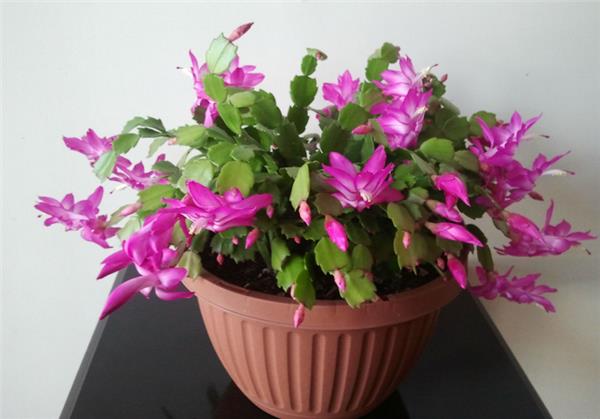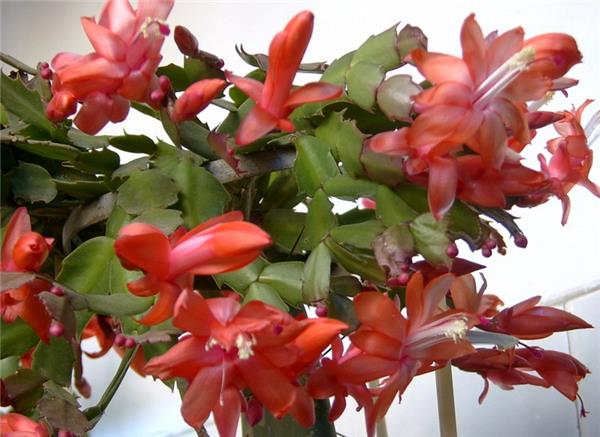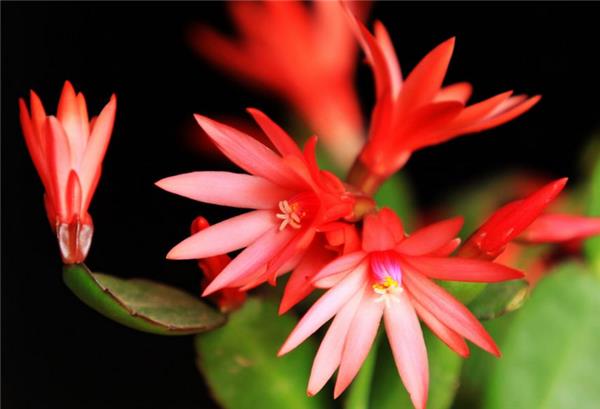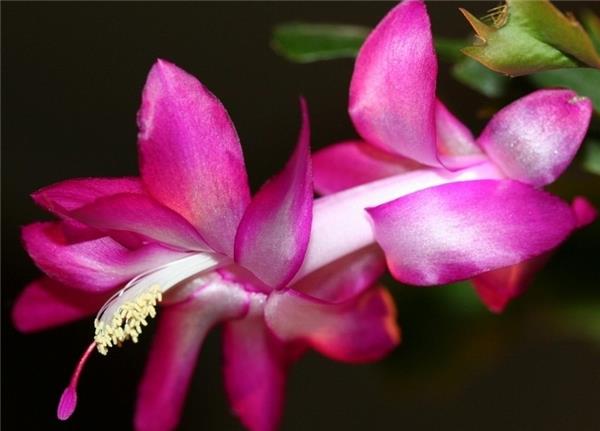Culture methods and matters needing attention of crab claw lotus
Crab claw lotus belongs to the genus Cactus of the family Cacti. Because the joint diameter is shaped like the secondary claw of a crab, it is called crab claw lotus, so let's take a look at the breeding methods and matters needing attention.

1. Selection of flowerpots for crab claw lotus culture
(1) flowerpot requirements: muddy flowerpots, plastic pots, porcelain pots and pottery pots can be used, but muddy flowerpots are better. In order to coordinate with home decoration, it can be cultivated in plastic flowerpots with changing colors.
(2) flowerpot size: crab claw lotus should be cultivated in a pot with a crown diameter of 2 to 3 pots.
two。 Preparation of basin soil for culture of crab claw lotus
Crab claw lotus likes rich, loose soil.
The following formula can be used for families: garden soil: rotten leaf soil: sand = 3RU 4RU 3; peat soil: Sand: perlite (or volcanic rock) = 4Rd 2RU 2RU 2. After the soil is prepared, it is best to use it after high temperature disinfection, or it can be sterilized in the sun.

3. The watering method of crab claw lotus culture
Crab claw lotus likes wet soil and avoids dampness. After the sprouting of leaf buds in spring, the amount of water can be gradually increased to keep the soil moist, and attention should be paid to the wetness between dry and dry when watering. Spring and autumn is the vigorous growth season of crab claw lotus, in addition to watering, but also should often sprinkle water around the plant to increase air humidity.
Crab claw lotus in the summer temperature is high, such as water supply, there will be growth stagnation, so summer should pay attention to watering, but the basin soil should not be too wet to prevent high temperature and humidity caused by rot. However, attention should be paid to spraying around it several times a day and strengthening ventilation in order to achieve the purpose of humidification and cooling.
Pay attention to the watering of dry wetlands after the temperature gets cooler at the end of autumn. When the temperature is low in winter and early spring, the growth is slow, so the basin soil should be in a dry state.
4. Fertilization method for culture of crab claw lotus
Crab claw lotus likes fertilizer, when the fertilizer is sufficient, there are many branches and flowers. After sprouting, the leaves of crab claw lotus began to be fertilized. In the growing season, 10 times of rotten liquid fertilizer mixed with 1000 times of potassium dihydrogen phosphate solution, or 1000 times of "Huaduoduo" general fertilizer could be applied once every 15 days.
The times of fertilization should be reduced at the end of autumn and should be stopped when the temperature is below 10 ℃. No fertilization is applied when the summer temperature is high and the winter temperature is low.
Fertilizing crab claw lotus should be thin and diligent, not thick. When fertilizing, apply the thin nozzle spray pot slowly along the edge of the basin, do not splash the fertilizer liquid on the leaves, otherwise it is easy to burn.

5. Light requirements of crab claw lotus culture
Crab claw lotus afraid of hot and high temperature, avoid exposure and rain, so summer should be placed in indoor ventilation or shady balcony. After the Beginning of Autumn, crab claw lotus gradually return to growth, should be placed in 50% of the light, such as shade shed or sunny window, in order to receive light and promote flower bud differentiation; as the weather turns cooler, the light should be increased gradually, and sufficient light should be given from late autumn to winter.
6. Four Seasons Management of Crab claw Lotus Culture
(1) Spring management
Change the basin every year before it germinates in early spring. The young plants change the pots once a year, and the adults change the pots once every 2-3 years. Before changing the basin, stop watering 2mi for 3 days, make the basin soil dry and remove the basin. Handle it gently to prevent it from breaking. The newly planted crab claw lotus is not watered for the time being, it is only sprayed 2-3 times a day or placed in a place with high humidity, and a small amount of water can be watered after 7 days. Leaf buds can be watered to keep the soil moist after sprouting.
After changing the basin to survive in spring, it should be arranged on the windowsill with sufficient light. After the temperature rises, it begins to resume growth, and the amount of water can be gradually increased to keep the basin soil moist, and attention should be paid to the wetness between dry and dry when watering. When the outdoor temperature is stable above 15 ℃, it can be cultured on a balcony with light but no rain. Pay attention to the supply of water and fertilizer during the peak growing season, but the soil must not be too wet, and it is appropriate to water the soil after it is dry. Rain Water should reduce the frequency of watering in more weather. The temperature is higher at the end of spring, so the noon light should be shaded or moved to a half-light place for cultivation.
(2) Summer management
Crab claw lotus is not resistant to the sun, summer should be placed in the semi-shady windowsill or balcony culture, can also be placed in bright indoor culture. Maintain an adequate water supply. When the temperature is cool at the end of summer, the water supply can be gradually increased and topdressing can be restored.
(3) Autumn management
In autumn, crab claw lotus should be cultured in a place with light in the morning and evening. Water the soil immediately after it is dry, and pay attention to the spray to replenish the air humidity. Attention should be paid to the supply of water and fertilizer after flower buds. When the temperature drops to about 10 ℃, it should be moved into the closed balcony or room with light in time, and the number of fertilization should be reduced.
As the buds fall off easily, care should be taken to avoid touching the buds when handling.
(4) Winter management
Crab claw lotus is not cold-resistant, and the indoor temperature should be kept above 10 ℃ in winter. Crab claw lotus should be placed in sufficient light on the windowsill or balcony cultivation, watering should not be frequent, see the soil dry before watering, do not fertilize.
(5) florescence management
After flowering, if moved to indoor layout with scattered light and 5-8 ℃, the flowering period can be prolonged, and watering should not be much, and it is appropriate to water again after seeing the soil dry.

7. Matters needing attention in the Culture of Crab claw Lotus
(1) after the autumn is cool, the crab claw lotus should be placed in a sunny place indoors. If autumn and winter do not get enough sunlight, the formed buds will fall off and blossom will decrease or not.
(2) when the growth of crab claw lotus plant is large, it is easy to be top-heavy and light, and it needs to be tied up, which can be supported by iron wire and other things. After the failure of the crab claw lotus, the residual flowers should be cut off together with the flowering stem nodes at the end, and pay attention to water control, so that the basin soil can be watered after the new buds grow.
(3) the upper basin soil of grafted seedlings can use 3 parts of rotten leaf soil, 4 parts of garden soil and 3 parts of river sand, plus a small amount of organic fertilizer or bone powder as base fertilizer. The basin is usually changed every 1-2 years. The change of pots should be carried out after the flowers bloom and fail in spring.
(4) in early spring, the dormancy period of crab claw lotus flower is about 40 days, at this time, watering should be controlled, but pay attention to loosening the soil and keep the basin soil dry; when the top begins to sprout, start watering to keep the basin soil moist, but avoid stagnant water in the basin, so as not to cause rotten roots; enter the summer high temperature season, crab claw lotus is dormant or semi-dormant, should be less watering, keep the basin soil semi-wet, avoid rain After autumn, as the weather turns cool, crab claw lotus gradually returns to growth and begins normal watering to keep the basin soil moist; in bud stage, it is necessary to spray water frequently to keep abnormal stems and buds moist, and watering is appropriate to keep the soil moist; after flowering, watering should be controlled to prolong the flowering period.
7. Matters needing attention in the Culture of Crab claw Lotus
(1) after the autumn is cool, the crab claw lotus should be placed in a sunny place indoors. If autumn and winter do not get enough sunlight, the formed buds will fall off and blossom will decrease or not.
(2) when the growth of crab claw lotus plant is large, it is easy to be top-heavy and light, and it needs to be tied up, which can be supported by iron wire and other things. After the failure of the crab claw lotus, the residual flowers should be cut off together with the flowering stem nodes at the end, and pay attention to water control, so that the basin soil can be watered after the new buds grow.
(3) the upper basin soil of grafted seedlings can use 3 parts of rotten leaf soil, 4 parts of garden soil and 3 parts of river sand, plus a small amount of organic fertilizer or bone powder as base fertilizer. The basin is usually changed every 1-2 years. The change of pots should be carried out after the flowers bloom and fail in spring.
(4) in early spring, the dormancy period of crab claw lotus flower is about 40 days, at this time, watering should be controlled, but pay attention to loosening the soil and keep the basin soil dry; when the top begins to sprout, start watering to keep the basin soil moist, but avoid stagnant water in the basin, so as not to cause rotten roots; enter the summer high temperature season, crab claw lotus is dormant or semi-dormant, should be less watering, keep the basin soil semi-wet, avoid rain After autumn, as the weather turns cool, crab claw lotus gradually returns to growth and begins normal watering to keep the basin soil moist; in bud stage, it is necessary to spray water frequently to keep abnormal stems and buds moist, and watering is appropriate to keep the soil moist; after flowering, watering should be controlled to prolong the flowering period.
Related
- Wuhan Hospital Iron Tree Blooming Result Was Instantly Frightened by the Gardener Master
- Which variety of camellia is the most fragrant and best? Which one do you like best?
- What is the small blue coat, the breeding methods and matters needing attention of the succulent plant
- Dormancy time and maintenance management of succulent plants during dormancy
- Minas succulent how to raise, Minas succulent plant pictures
- What are the varieties of winter succulent plants
- How to raise succulent plants in twelve rolls? let's take a look at some experience of breeding twelve rolls.
- Attention should be paid to water control for succulent plants during dormant period (winter and summer)
- Watering experience of twelve rolls of succulent plants
- Techniques for fertilizing succulent plants. An article will let you know how to fertilize succulent plants.



